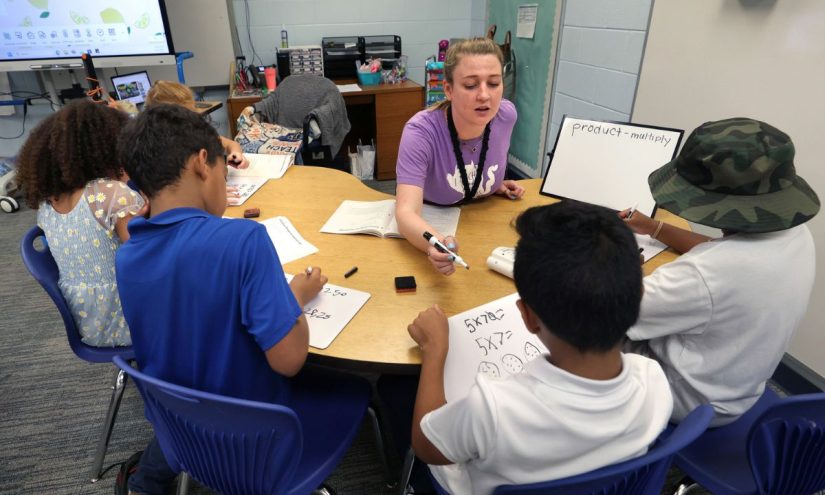
The 74
America's Education News Source
Copyright 2025 The 74 Media, Inc
Sign up for our free newsletter and start your day with in-depth reporting on the latest topics in education.
Get stories like this delivered straight to your inbox. Sign up for The 74 Newsletter
No state in America has seen more change in its K-12 offerings than Florida: 500,000 students are now using choice scholarships for private schools or a la carte education; and more than half of all students – 1.8 million – are enrolled in something other than their zoned neighborhood schools. But even amid this dynamic, choice-driven landscape, some families still can’t access or afford the schools they want.
For the 2024-25 school year, roughly 41,000 Florida students who were awarded choice scholarships from the state’s two, main, general population programs didn’t use them. We wanted to know why, so our nonprofit, Step Up for Students, surveyed their parents. More than 2,700 shared their insights with us, which we detail in a new report, “Going With Plan B.”
The first takeaway speaks to supply-side challenges.
Availability and affordability were the two biggest reasons parents didn’t use their scholarships: Just over a third of the respondents said there were no available seats at the private school they wanted; one in five said the scholarship amounts, worth roughly $8,000 each, weren’t enough to cover tuition and fees or additional costs.
These challenges aren’t really a surprise. Over the past 10 years, the number of private school students has grown by 39%, while the number of private schools has grown by 31%. That’s a net gain of 706 schools for a sector serving another 124,644 students. That’s a lot. But two years into “universal” eligibility, it’s not enough.
Here, though, is where the survey results take some interesting turns. Consider:
In other words, as a whole these parents started their school choice journey feeling okay about their kids’ schools. They didn’t use their choice scholarships but still found options they liked better. Better, though, doesn’t mean good enough – so their journey continues.
This isn’t the choice narrative we’re used to, the one shaped by parents desperate to find better options for struggling kids. At this point in the evolution of choice in Florida, though, maybe it makes sense.
With more and better options surfacing all the time — and from all directions, including districts — maybe parents are not as desperate as they were when choice began ramping up a generation ago. Maybe they’re no longer settling for schools that are just a little better or different. Maybe they’re instead expecting schools that are just right.
Expanding eligibility might be playing a role here.
Florida is one of 19 states with universal eligibility for choice, and one of five offering the full monty of universal eligibility, flexible spending, and full funding. The scholarships are no longer limited to low-income families and those with students who have special needs. And our survey found higher-income families were more satisfied with their education situation at both the beginning and the end of their scholarship journey.
But we saw the same trends for low-income families: At the beginning of the process, 51.1% were satisfied and 33.8% were not. At the end, the corresponding rates were 47.6% and 22.4%.
None of this minimizes the opportunity for policymakers, philanthropists, and choice advocates – in Florida and beyond – to put more focus on the supply side. There’s progress to be made in mitigating building and zoning barriers for new providers; in modernizing transportation systems; and in making start-up capital available to more school founders. Perhaps enhancing scholarship amounts for low-income families should be more central to choice conversations, as well.
If anything, the survey results rev up urgency for all those initiatives. Even in the state with the most school choice options, parents want more – and they’re not settling for less.
Get stories like these delivered straight to your inbox. Sign up for The 74 Newsletter
Ron Matus is director, research and special projects, at Step Up For Students, the nonprofit that administers Florida’s education choice scholarship programs, and a former newspaper reporter.
Dava Cherry is the former director, enterprise data and research, at Step Up For Students, the nonprofit that administers Florida’s education choice scholarship programs, and a former public school teacher.
We want our stories to be shared as widely as possible — for free.
Please view The 74’s republishing terms.
By Ron Matus & Dava Cherry
This story first appeared at The 74, a nonprofit news site covering education. Sign up for free newsletters from The 74 to get more like this in your inbox.
No state in America has seen more change in its K-12 offerings than Florida: 500,000 students are now using choice scholarships for private schools or a la carte education; and more than half of all students – 1.8 million – are enrolled in something other than their zoned neighborhood schools. But even amid this dynamic, choice-driven landscape, some families still can’t access or afford the schools they want.
For the 2024-25 school year, roughly 41,000 Florida students who were awarded choice scholarships from the state’s two, main, general population programs didn’t use them. We wanted to know why, so our nonprofit, Step Up for Students, surveyed their parents. More than 2,700 shared their insights with us, which we detail in a new report, “Going With Plan B.”
The first takeaway speaks to supply-side challenges.
Availability and affordability were the two biggest reasons parents didn’t use their scholarships: Just over a third of the respondents said there were no available seats at the private school they wanted; one in five said the scholarship amounts, worth roughly $8,000 each, weren’t enough to cover tuition and fees or additional costs.
These challenges aren’t really a surprise. Over the past 10 years, the number of private school students has grown by 39%, while the number of private schools has grown by 31%. That’s a net gain of 706 schools for a sector serving another 124,644 students. That’s a lot. But two years into “universal” eligibility, it’s not enough.
Here, though, is where the survey results take some interesting turns. Consider:
In other words, as a whole these parents started their school choice journey feeling okay about their kids’ schools. They didn’t use their choice scholarships but still found options they liked better. Better, though, doesn’t mean good enough – so their journey continues.
This isn’t the choice narrative we’re used to, the one shaped by parents desperate to find better options for struggling kids. At this point in the evolution of choice in Florida, though, maybe it makes sense.
With more and better options surfacing all the time — and from all directions, including districts — maybe parents are not as desperate as they were when choice began ramping up a generation ago. Maybe they’re no longer settling for schools that are just a little better or different. Maybe they’re instead expecting schools that are just right.
Expanding eligibility might be playing a role here.
Florida is one of 19 states with universal eligibility for choice, and one of five offering the full monty of universal eligibility, flexible spending, and full funding. The scholarships are no longer limited to low-income families and those with students who have special needs. And our survey found higher-income families were more satisfied with their education situation at both the beginning and the end of their scholarship journey.
But we saw the same trends for low-income families: At the beginning of the process, 51.1% were satisfied and 33.8% were not. At the end, the corresponding rates were 47.6% and 22.4%.
None of this minimizes the opportunity for policymakers, philanthropists, and choice advocates – in Florida and beyond – to put more focus on the supply side. There’s progress to be made in mitigating building and zoning barriers for new providers; in modernizing transportation systems; and in making start-up capital available to more school founders. Perhaps enhancing scholarship amounts for low-income families should be more central to choice conversations, as well.
If anything, the survey results rev up urgency for all those initiatives. Even in the state with the most school choice options, parents want more – and they’re not settling for less.
Copyright 2025 The 74 Media, Inc

Recent Comments